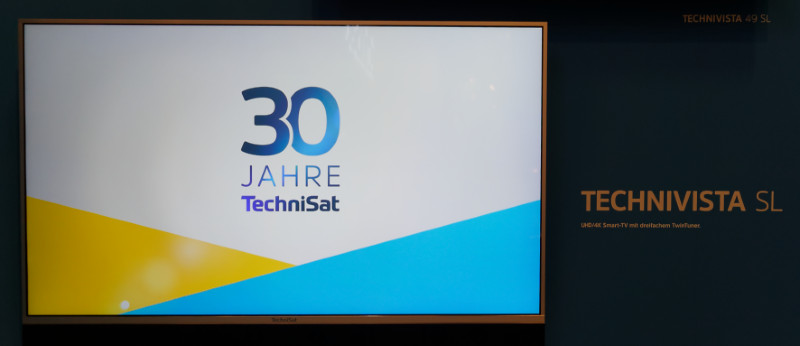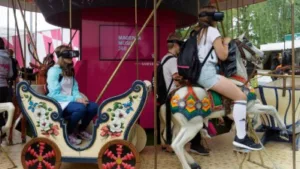Aiptek, the specialist in pico-projectors, was showing the AN100, a really small projector that can produce 100 lumens of HD output and includes a full Android 5.1 system. Features include content playback from SD or USB and the device can also mirror content from a smartphone or tablet. Pricing is €320
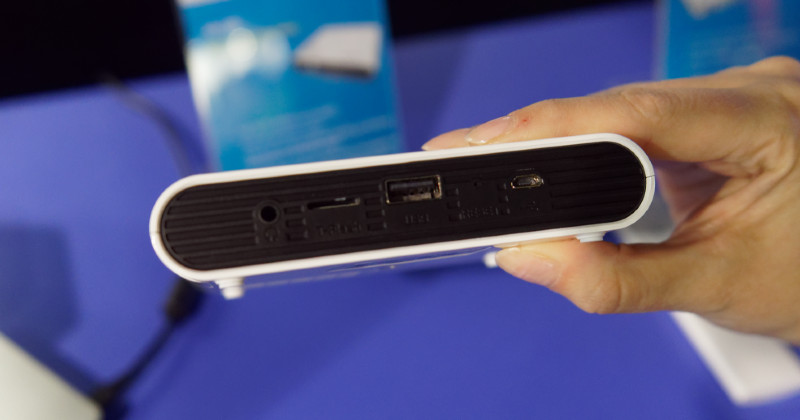 Aiptek’s AN100 is very slim and has Android. Image:Meko
Aiptek’s AN100 is very slim and has Android. Image:Meko
The P800 is a full system including a 5.2″ FullHD top display to run the system that also includes good 360 deg audio and can provide 800 lumens of output with 1280 x 800 resolution. It will ship in November for around €999.
Finally, we looked at the AN50VT which uses the Aiptek ‘wand’ system which uses special pointers that can be tracked by the projector to allow them to be used interactively. Resolution is 1280 x 800 and output is 500 Ansi lumens. As with the other projectors, a full Android system is included and the unit will cost from €800 to €850 when it ships at the end of the year.
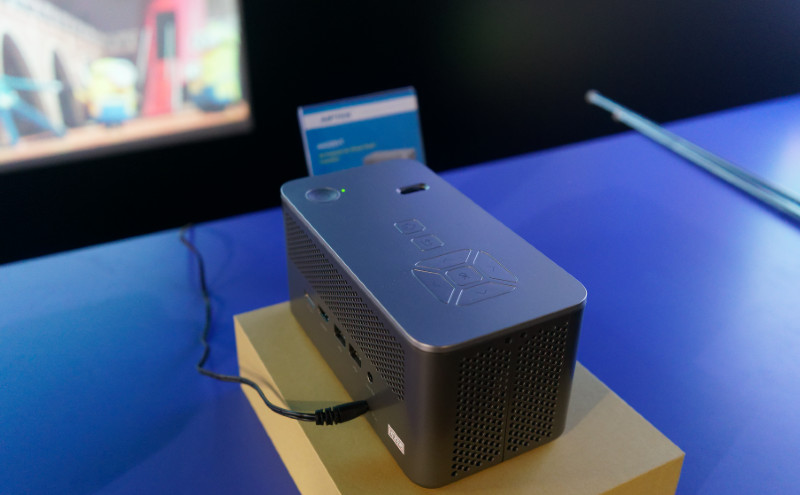 Aiptek’s AN50VT can detect special ‘wands’ that allow interactivity. Image:Meko
Aiptek’s AN50VT can detect special ‘wands’ that allow interactivity. Image:Meko
Alcatel was showing new smartphones at the show, the Idol 5 and the A7 (both of which have two variants) and which will start to ship in October.
The A7 is available with a 5.5″ IPS FullHD display (or 6″ on the A7XL). The phone has a Mediatek MT6750T processor, 3GB of RAM and 32GB of storage with microSD. The cameras are 16MP and 8MP and the battery is a fixed 4000 mAh.
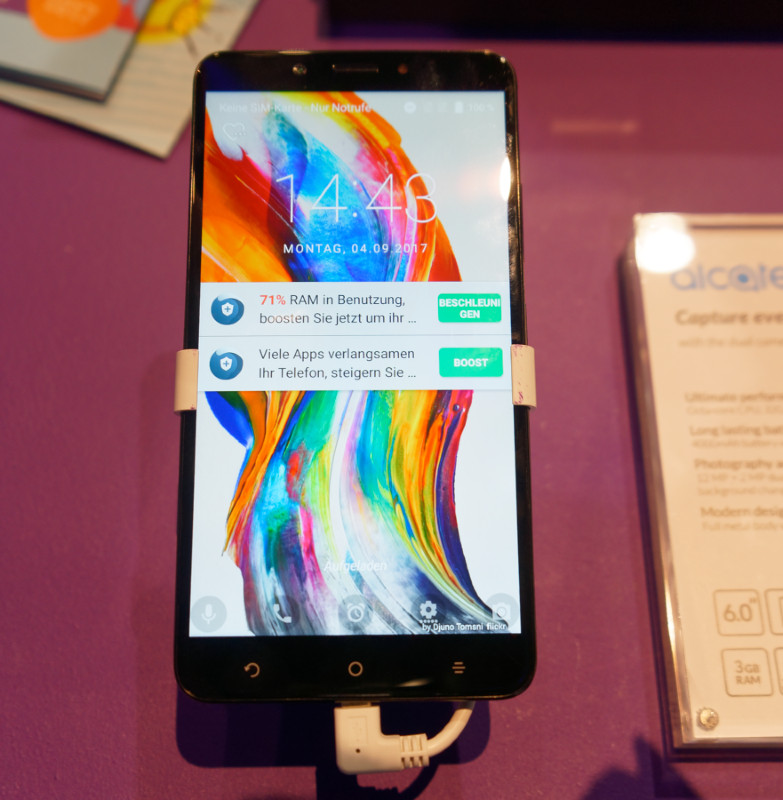 Alcatel’s A7 has 5.5″ and 6″ IPS LCD variations. Image:Meko
Alcatel’s A7 has 5.5″ and 6″ IPS LCD variations. Image:Meko
The Idol 5 has a 5.2″ FullHD LCD with Asahi Dragontail glass and using an oleophobic coating. The Processor is a Mediatek MT6573 with 3GB of RAM and 16GB of storage. The cameras are 13MP and 5MP. The 5S has the same size display but a better processor, the MT6767 Helio P20 with a Mali-T880 GPU. The cameras are 12MP and 8MP.
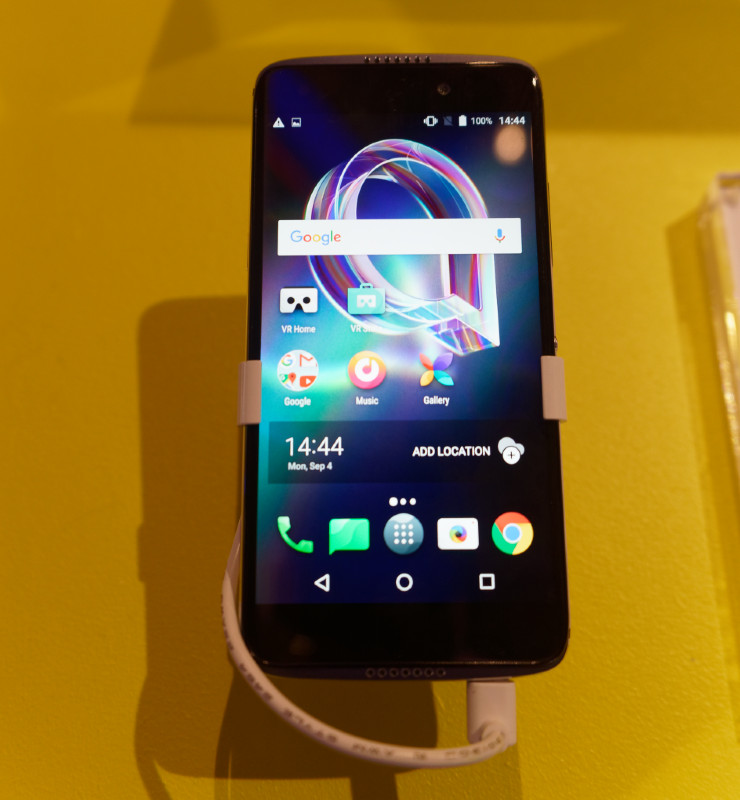 Alcatel’s Idol 5. Image:Meko
Alcatel’s Idol 5. Image:Meko
Caterpillar was at the show with its range of extremely rugged phones and showed the S31 and S41 which both have touch systems that can work with wet or gloved fingers.
The Cat S31 has a 4.70″ 720 x 1280 display (Gorilla Glass 3) with a Snapdragon 210 processor and it comes with 2GB of RAM and 16GB of storage with expansion by microSD cards. There is an 8MP rear camera and 2MP front. The phone runs Android 7.1 and has a 4000mAh non-removable battery. It measures 146.00 x 74.42 x 12.60 (height x width x thickness) and weigh 200 grams. It supports dual SIMs. The phone is rugged
- IP68 certified – dust/water proof over 1.2 meters and 35 minutes
- Drop-to-concrete resistance from up to 1.8 m
- MIL-STD-810G compliant – salt, dust, humidity, rain, vibration, solar radiation, transport and thermal shock resistant
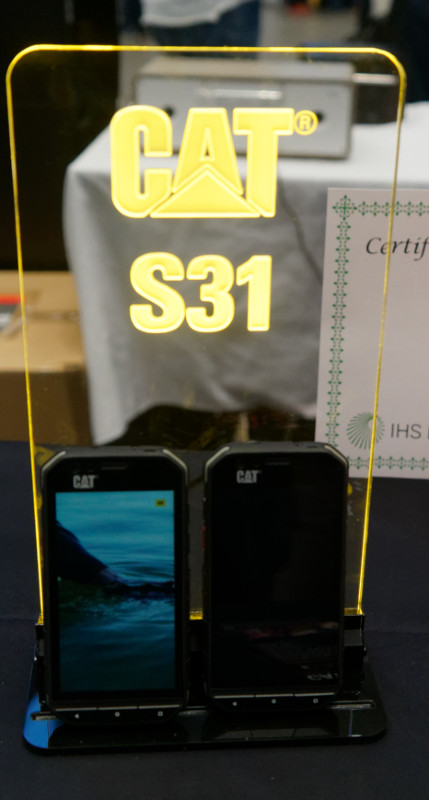 The Cat S31 phone has a 4.7″ display. Image:Meko
The Cat S31 phone has a 4.7″ display. Image:Meko
The S41 boosts many factors. It has a 5″ IPS LCD display with Gorilla Glass 5 and with FullHD resolution. There is 3GB of RAM and 32GB of standard storage. The AP is a Mediatek MT6757 Helio P20 and the GPU is a Mali-T880 MP2. Camers are upgraded to 13MP and 8MP. It is more rugged than the S31 and the battery capacity is boosted to 5,000mAh for 44 dsays of standby or 38 hours of talk time. The display is described as ‘super bright’, but we haven’t been able to get a number for this.
- IP68 certified – dust/water proof over 2.0 meters and 60 minutes
- Drop-to-concrete resistance from up to 1.8 m
- MIL-STD-810G compliant – salt, dust, humidity, rain, vibration, solar radiation, transport and thermal shock resistant
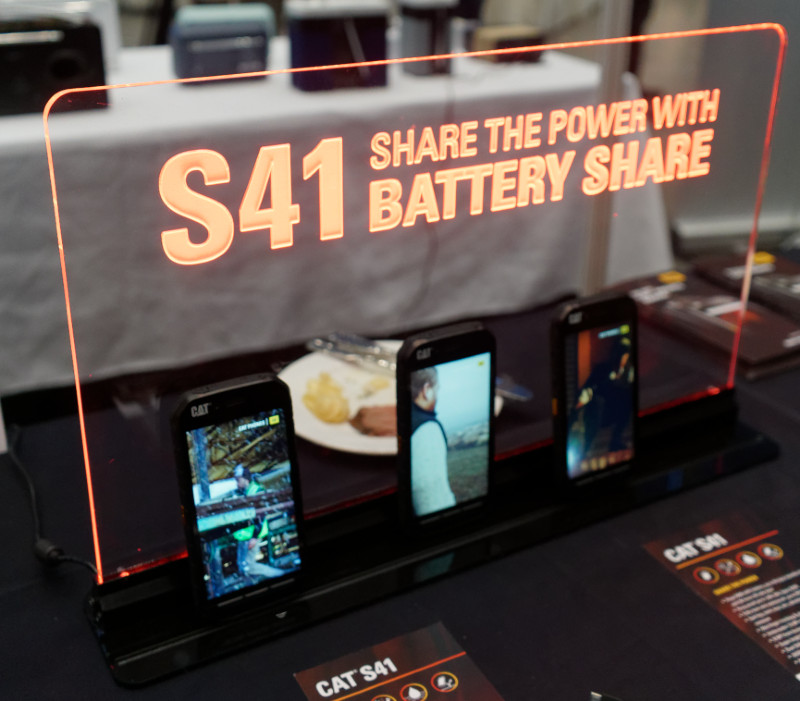 The Cat phones can share spare battery power wirelessly if one handset has spare capacity. Image:Meko
The Cat phones can share spare battery power wirelessly if one handset has spare capacity. Image:Meko
JVC had a very impressive home cinema set up to shot its high end LCOS devices. The company had a bright red ‘special edition’ model, the DLA-20LTD that uses the e-shift mode to offer the playback of UltraHD sources. The contrast is claimed to be 200,000:1 on this model which is expected in October.
 This JVC prototype is not designed to be inconspicuous. Image:Meko
This JVC prototype is not designed to be inconspicuous. Image:Meko
There are three new versions of the big D-ILA unit, the DLA-X9900, the DLA-X7900 and the DLA-X5900. The top of the range 9900 has 1900 lumens of brightness as well as 160,000:1 contrast, the 7900B has slightly less contrast at 120,000:1 and the 5900 drops the output to 1,700 lumens with contrast down at 40,000:1.
Unfortunately qualified staff to discuss the products in detail were tied up with demos when we visited the booth However, image quality in those demonstrations was superb, right up there with the best possible, as is often the case with the JVC projectors.
 JVC showed this D-ILA Roadmap Image:Meko. Click for higher resolution
JVC showed this D-ILA Roadmap Image:Meko. Click for higher resolution
Microsoft was showing mixed reality headsets from its partners. Much of the booth was taken up with the X Box range and the company’s Windows team also gave a keynote that revealed that the Creators’ Edition of Windows 10, which is needed to enable these headsets, will be released on October 17th.
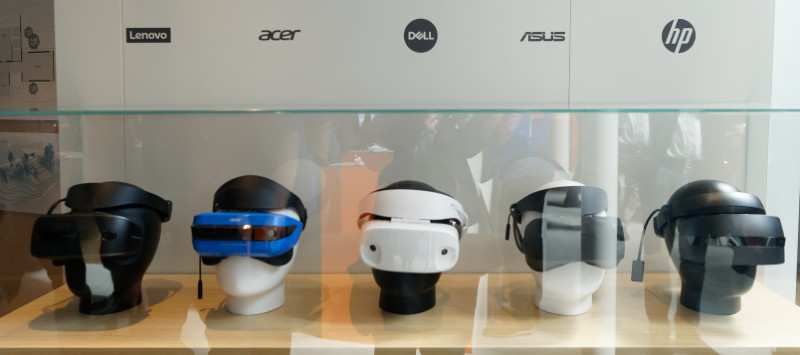 Microsoft showed Mixed Reality headsets from its partners. Image:Meko
Microsoft showed Mixed Reality headsets from its partners. Image:Meko
Optoma was showing the UHZ65 a new L/P-based UltraHD DLP projector that it is expected to start to ship in Q4 of this year and was shown at Infocomm. Lots of details are still to be decided, but brightness is expected to be about 2,500 ANSI lumens and with 100% support for Rec. 709 colour. It will have a 1.35 to 2.22 zoom lens The projector will have PureMotion processing for better motion compensation and is likely to cost around €5,000 although this will be confirmed nearer the shipping date.
 Optoma UHZ65 projector. Image:Meko
Optoma UHZ65 projector. Image:Meko
Also being shown by Optoma was the ZH400UST which is a laser-phosphor-based UST projector for home and professional use and that was first shown at ISE earlier this year. It was being shown with the ALR100 screen that the company supplies for use with the projector and which costs between €800 and €1000. There was quite high ambient light, but despite this the performance with the ALR100 was good with surprisingly high contrast.
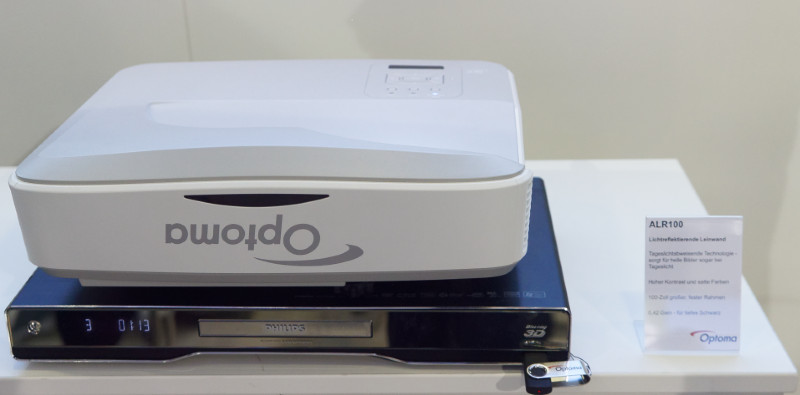 Optoma’s UST projector. Image:Meko
Optoma’s UST projector. Image:Meko
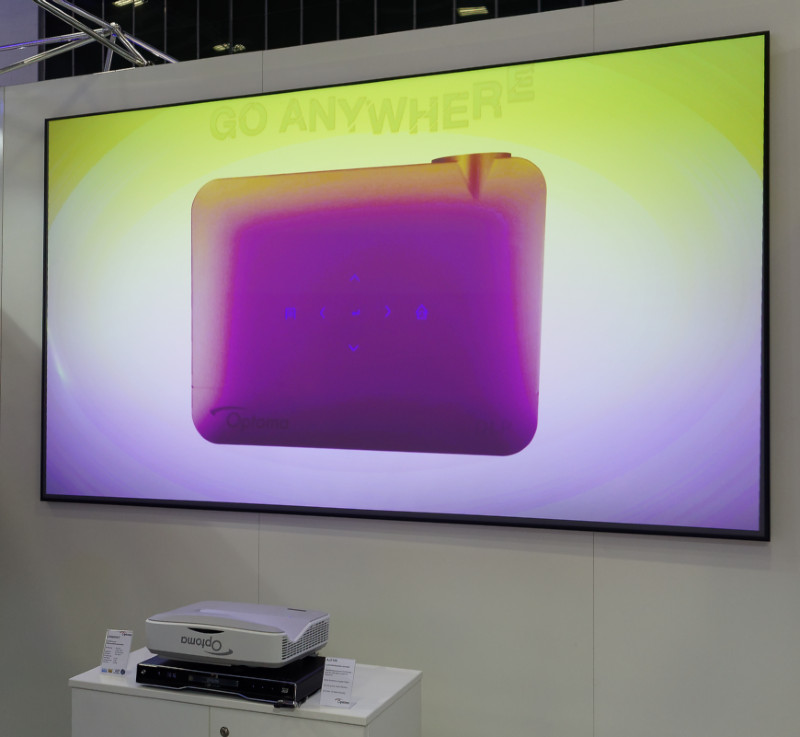 Despite high ambient light the Optoma UST projector with its special screen looked very good. Image:Meko
Despite high ambient light the Optoma UST projector with its special screen looked very good. Image:Meko
On its booth, Panasonic had a design study prototype of a ‘wedge of glass’ that contained a TV. We were less convinced by this than we were with the more traditional transparent TV that the company showed previously at IFA and also at CES,
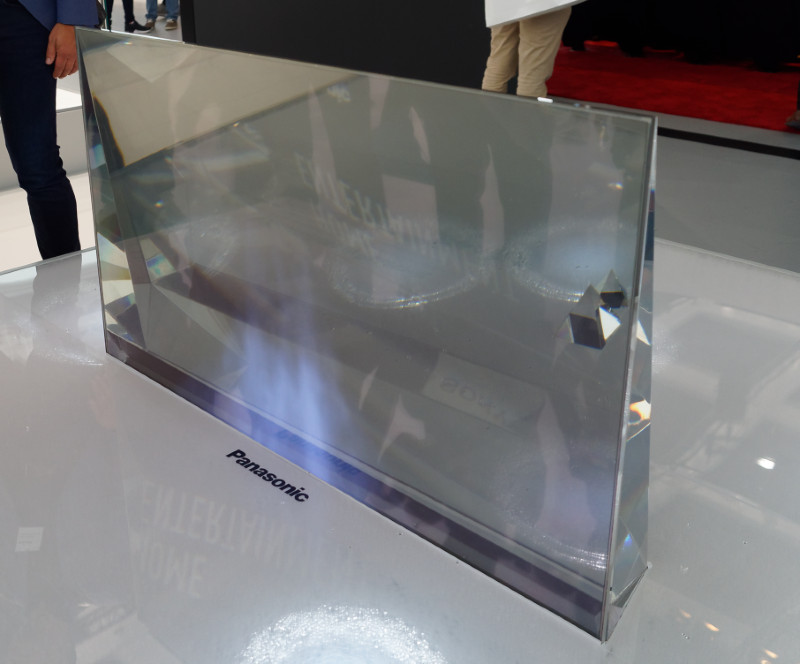 Panasonic had a glass wedge TV concept. Image:Meko
Panasonic had a glass wedge TV concept. Image:Meko
On the part of the Samsung stand reserved for startups, Opus One (which sounds like a high end hi-fi component) has a box to turn an old smartphone into a CCTV receiver and has a cradle that connects to the IoT for using it in surveillance.
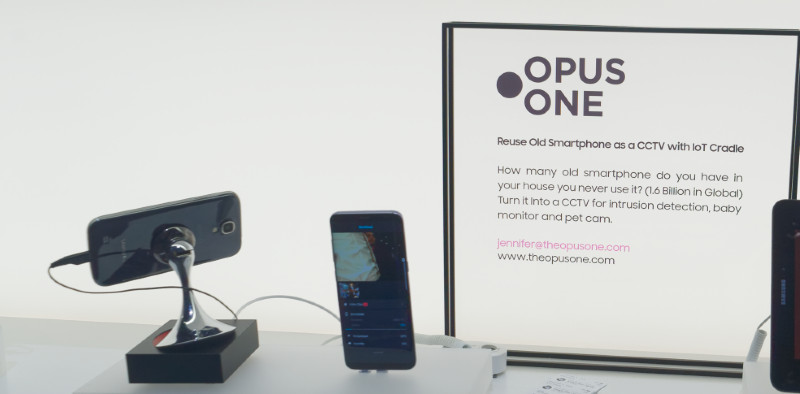 OPUS One turns old smartphones into surveillance cameras. Image:Meko
OPUS One turns old smartphones into surveillance cameras. Image:Meko
One of the bizarre sights at the show was a demonstration of VR by Deutsche Telekom and Samsung that gave VR headsets to those on a roundabout to give a different point of view!

Technisat is one of the ’boutique’ makers of TVs in Germany, along with Metz and Loewe (which both have Asian connections now) and was the only one that was not showing OLEDs. Their was a new set with a VA panel in 49″ and 55″ and UltraHD resolution and there are ‘triple twin tuners’ – that is to say dual DVB S-2, T-2 and C tuners, one of which can record while the other is displaying.
